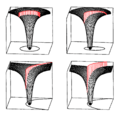Circular orbit facts for kids
In astronomy, an orbit is the path an object takes around another object in space. A circular orbit is a special kind of orbit where an object, like a satellite, moves in a perfect circle around a central body, like a planet. This means the object stays the same distance from the center all the time. This type of movement follows important rules known as Kepler's Laws. A perfectly circular orbit happens when its "eccentricity" is exactly zero.
Contents
What is a Circular Orbit?
A circular orbit describes an object moving in a perfect circle around a larger object. Imagine a ball tied to a string, swinging around your hand in a perfect circle. In space, this means a satellite or a planet keeps a constant distance from the object it orbits. This steady path is guided by the force of gravity.
Why are Circular Orbits Rare?
Even though we talk about circular orbits, they are quite rare in space. Most objects, like the Moon orbiting the Earth, actually move in an elliptical orbit. An elliptical orbit is shaped more like a stretched circle or an oval. The planets in our Solar System also move in elliptical paths around the Sun.
Understanding Eccentricity
The shape of an orbit is described by something called eccentricity.
- If an orbit has an eccentricity of 0, it is a perfect circle.
- If the eccentricity is greater than 0 but less than 1, the orbit is an ellipse (an oval shape).
- If the eccentricity is 1, it's a parabolic trajectory. This means the object escapes the central body's gravity.
- If the eccentricity is greater than 1, it's a hyperbolic trajectory. The object also escapes, but on a different path.
Because many things can affect an object's path in space, like the gravity of other nearby objects, it's very hard for an orbit to be perfectly circular. This is why elliptical orbits are much more common.
Other Types of Orbits
Besides circular orbits, objects in space can follow other paths:
- Elliptical orbit: This is the most common type, shaped like an oval. Planets and most satellites follow elliptical paths.
- Parabolic trajectory: An object on this path has just enough speed to escape the gravity of the central body. It will not return.
- Hyperbolic trajectory: An object on this path has too much speed and will definitely escape the central body's gravity. It also will not return.
Images for kids
See also
 In Spanish: Órbita circular para niños
In Spanish: Órbita circular para niños


